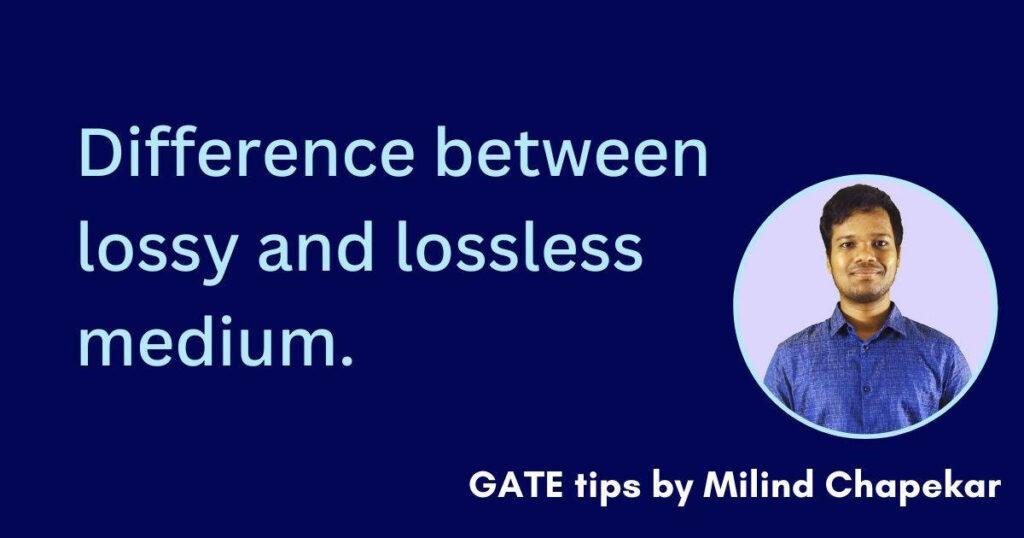The words “Lossy Medium” and “Lossless Medium” are common while studying the EM wave phenomenon. In simple words, lossy nature corresponds to the losing EM power when a wave travels through the medium.
In this article, we embark on a journey through the realms of lossy and lossless medium and let us see the difference between lossy and lossless medium.
We will see thoroughly how to differentiate media into lossy or lossless.
You can watch a quick video or read along. Just click here,
What is Lossy and lossless medium
In the vast landscape of modern technology, where digital content dominates our daily lives, the choice of the medium becomes a critical consideration.
While studying EM wave propagation, you must have heard the terms like lossy medium and lossless medium.
Let us first see the definitions of lossy and lossless medium.
Lossy medium:- It is the medium, where the EM wave loses its power.
Lossless medium:– It is the medium, where the EM wave does not lose power.
We will understand this in detail.
When the electromagnetic wave travels, we know that it carries electromagnetic power with it. While traveling if the EM wave loses its power, then the medium where the wave is traveling is called a lossy medium.
Whereas, when the wave is propagating and if it does not lose its power while propagating, then that medium where this EM wave is propagating is called a lossless medium.
Mathematical Representation
Now, Let us see the reason why an EM wave loses power while traveling through a lossy medium and it does not lose power while traveling through a lossless medium.
We know that the Power which is carried by is given by,
The average power carried by EM wave is given by,
P= \frac{1}{2}Re\left [ \overrightarrow{E_{s}}\times\overrightarrow H_{s} \right ] –(i)
Here, E – Electric field
H – magnetic field
The power of electromagnetic wave is given by the pointing theorem. From the equation, we see that Power is half of the real part.
The equation (i) can also be written as,
P= \frac{1}{2}Re\left [ \overrightarrow{E_{s}}\times \left ( \frac{\overrightarrow{E_{s}}}{\eta ^{*}} \right ) \right ]Magnetic field H can also be written in terms of E , simply by dividing the electric filed by intrinsic impedance ( \eta ) .
The equation is given as,
P= \frac{1}{2}Re\left [ \overrightarrow{E_{s}}\times \left ( \frac{|\overrightarrow{E_{s}|^{2}}}{\eta ^{*}} \right ) \right ]From this equation, we can say that the power of the EM wave is dependent on the magnitude of E wave or the amplitude of E wave.
The equation of EM wave is given as,
\overrightarrow{E}=E_{o}e^{-\alpha z}cos\; (\omega t-\beta z)\widehat{a_{x}}IN this equation, the amplitude of the wave is
A= E_{o}e^{-\alpha z}
Here z – direction of propagation
\alpha = attenuation constant
Let us consider two cases to understand the difference between lossy and lossless medium.
Case-I :- For lossless medium, When α=0,
As we know that the equation of the EM wave is
\overrightarrow{E}=E_{o}e^{-\alpha z}cos\; (\omega t-\beta z)\widehat{a_{x}}The Amplitude is A= E_{o}e^{-\alpha z}
Let us put α=0 , then we get A = Eo , which means we are getting constant power, as it is taking Eo , while propagating, It will carry constant power with it.
It is not losing power, as amplitude is constant. Therefore, the medium will be a lossless medium, as it is not losing any power while propagating.
As the amplitude is constant power will also be constant because Power will depend on the amplitude.
Case-II :- For lossy medium , the \alpha \neq 0 ,
In lossy medium the amplitude is not constant. It continuously losing power while propagating.
When EM wave travels through lossy medium, its amplitude decreases exponentially.
As amplitude will decrease power will also decrease.
The attenuation constant (α) had come from the propagation constant.
α is the real part of the propagation constant, and katex] \beta[/katex] is the imaginary part of the propagation constant.
While deriving Maxwell equation, we get the value of propagation constant which is given as,
\gamma =\sqrt{J\omega \mu (\sigma +J\omega \epsilon )}where, σ – conductivity, ε- permittivity , μ -conductivity
This is called the propagation constant . It is important while deriving the EM wave equations.
So, in general, we get propagation constant by deriving the Maxwell equation.
It can be written as, \gamma =\alpha +i\beta
α is the real part and \beta is the imaginary part.
Therefore, we conclude that
When we put , σ=0 in the equation of propagation constant then , by solving we get
\gamma =j\omega \sqrt{\mu \epsilon }therefore, when σ=0, α = 0 , it means the medium is a lossless medium as the attenuation constant is zero and amplitude is also constant, so it will not lose power .
But in case of lossy medium when \alpha \neq 0, \sigma \neq 0 , here amplitude will not be constant and it will lose power while propagating.
The basic property which decides the lossy nature of the medium is conductivity. So conductivity is important .
Now, let us summarize this all information in tabular form.
| Lossy Medium | Lossless Medium |
| \alpha \neq 0, \sigma \neq 0 | σ=0, α = 0 |
| Amplitude is not constant | Amplitude is constant. |
| EM wave loses power | EM wave does not lose power. |
Hope, so, this article had made your concept clear on the difference between lossy and lossless medium.
Do not forget to check our Awesome GATE courses.


